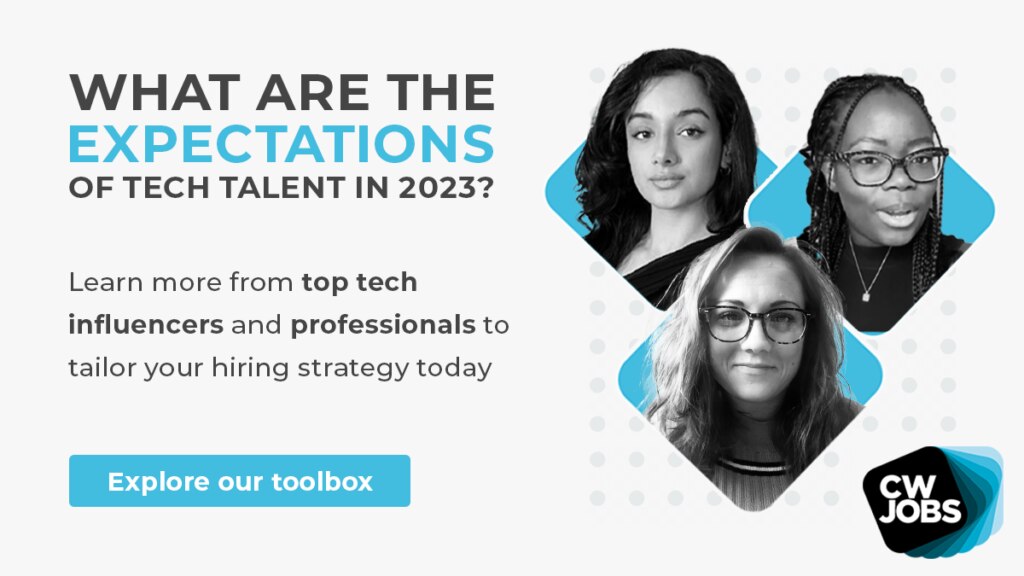A guide to hiring entry-level talent
Despite the current tech skills shortage, there’s still a huge talent pool of entry-level talent for companies to recruit from. We spoke to two young tech workers to gather their advice on how to attract entry-level tech talent.

CWJobs’ recent research has found that over two thirds of young adults (67%) are considering a career in tech as they search for a good salary (45%), an exciting industry (36%), and good future prospects (35%).
To learn more about how employers can attract entry-level talent, we spoke with two young tech workers – Hosanna Hali, an Azure Specialist, and Mash, a Software Developer. They shared their insights into what each role involves, and the skills and qualifications required to secure an entry-level role in tech.
We’ve gathered their insights into this article, and included some useful resources to help recruiters attract younger talent.
Define the role in detail
No two roles are the same, so it’s important for recruiters to provide as much detail as possible in job descriptions. Entry-level talent wants to know all the essential information up front, like salary, flexible working policies, and career development opportunities.
Companies should also provide information on their culture as it will determine what a typical day looks like for entry-level talent. For example, as an Azure specialist, Hosanna works with a portfolio of customers and provides them with advice and guidance on how to use cloud services. Her role is very customer-facing, she spends a lot of time in meetings, and skilling up on Azure.
Mash is a Software Developer and typically starts her day with a management meeting to discuss project updates. She then prioritises her tasks for the day and starts working on scripts to automate processes. Throughout the day, she attends various meetings about other projects.
Focus on soft skills as well as technical skills
As important as technical skills are, they’re often easier to acquire than ‘softer’ skills like time management, teamwork, and critical thinking. Employers shouldn’t dismiss candidates because they have limited experience or a basic level of technical skills.
If they have the motivation and enthusiasm, internal training and skills-based ‘bootcamps’ can help entry-level talent develop the expertise required to fulfil the role requirements.
The skills that Hosanna uses most in her job are communication, an ability to learn fast, and emotional intelligence to build relationships with customers and understand their needs.
Recruit from a diverse talent pool
Hosanna believes that the biggest challenge in tech is the shortage of talent and skills, as well as a lack of diversity. That’s why she uses her online platform to encourage more people to pursue a career in tech.
Certainly, our recent research has found that 75% of candidates consider a company’s diversity, equity and inclusion (DE&I) policy to be important when applying for a job.
Tools like Equality Boost can help companies reach entry-level talent by running targeted display advertising campaigns. The tool uses a unique blend of data science to pinpoint when, where and how to reach the tech talent that companies need.
Likewise, companies can improve diversity on a sector-wide scale by supporting organisations like Tech Talent Charter, whose aim is to deliver greater gender diversity in the UK’s tech workforce. Colorintech is another organisation who work towards creating a more transparent and inclusive tech economy by helping to close the skills and opportunity gap for underrepresented talent.
Embrace flexibility and outline working practices
According to research from Robert Half, 73% of tech leaders agree that remote working is limiting junior employees’ opportunities to develop new skills. Our own research has found that entry-level talent prefers a hybrid working model that gives them the flexibility of being able to work from home, and at the office.
For example, Mash explains that she has her morning management meeting in the office, then returns home at lunch for a change of working environment. This level of flexibility is appreciated by young tech workers, who seek a healthy work-life balance.
When it comes to interviewing and onboarding new talent, CWJobs’ Video Recruitment software provides a flexible, effective interview experience for companies and candidates alike. Our live interview feature also lets recruiters record live interviews and meetings.
Highlight the different routes into tech
Many young tech workers aren’t aware of the various routes into tech. And of course, there’s no one-size-fits-all path. For example, Hosanna did an undergraduate degree in Business and a Masters in Computer Science. She says there are many routes into the industry and a specialist tech job platform like CWJobs can help young talent find the right role for their skill level and experience.
Mash makes the point that a university qualification is not always needed to secure an entry-level role, as many skills can be learned through training programmes and bootcamps. She also recommends CWJobs for connecting tech candidates with top companies and job opportunities.
Our Early Careers Solutions helps employers engage tech talent as they start their career journey. A unique cluster of products enables companies to engage future hires with their brand story, extend their reach into early career talent pools, and reduce time to hire.
The Tech Talent Attraction Toolkit
To help employers reach, engage and nurture entry-level talent, we’ve created the Tech Talent Attraction Toolkit that can be accessed for free.
The toolkit includes:
- An insightful Top Tips guide based on Hosanna and Mash’s professional advice
- Two ‘Day in the Life’ videos based on Azure Specialist and Software Developer roles
- An exclusive interview with Kimberley Cook, Software Developer, and Director at codebar, providing advice for employers who are looking to sharpen their recruitment strategies
Download the Tech Talent Toolkit, here.
You can also access two complimentary comprehensive job guides below: